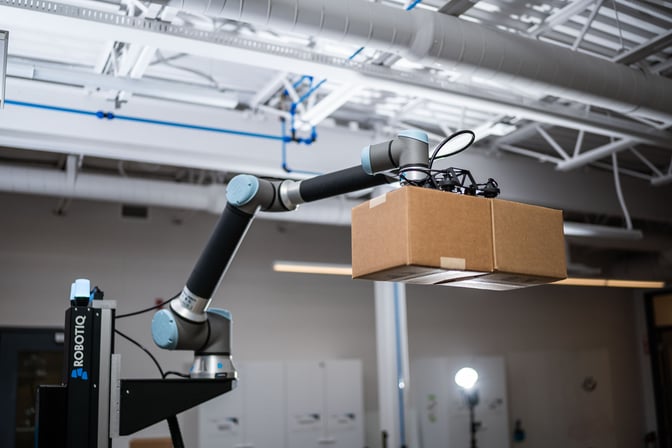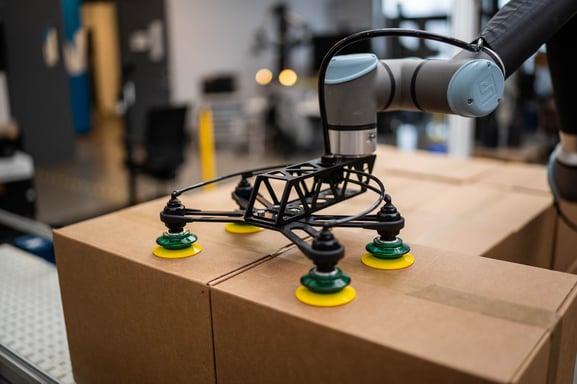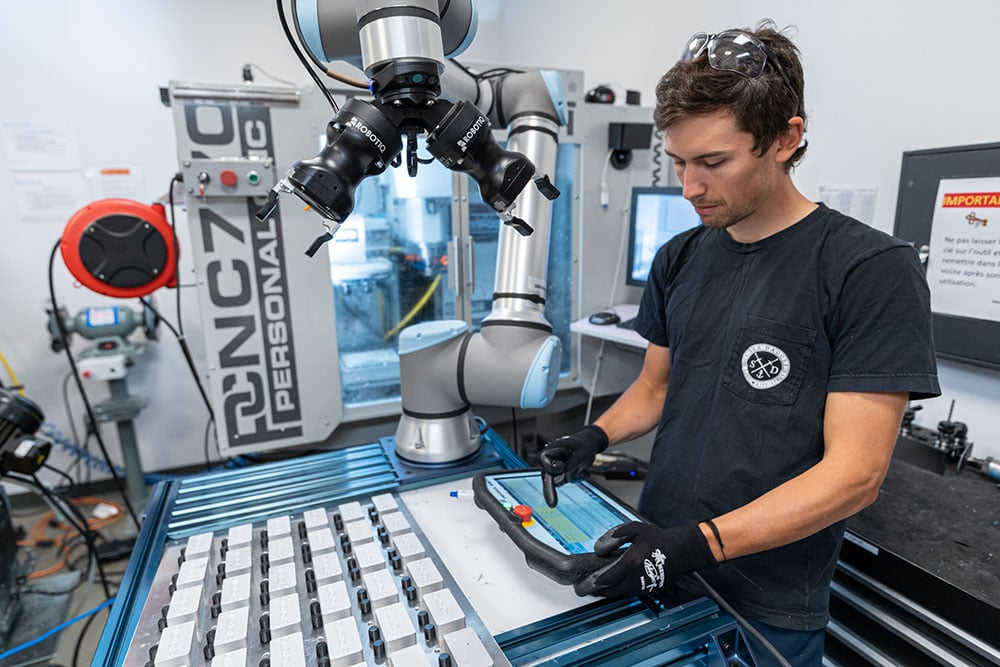Keeping Safe in the Palletizing Cell: Safety Tips & Best Practices

Posted on Jun 01, 2023 1:34 PM. 5 min read time
Palletizing is an important part of many industrial processes, but it can be dangerous if you don't take the proper safety precautions.
At first glance, palletizing might seem like a relatively risk-free task compared to others. It simply involves moving boxes of products from your production line onto waiting pallets. However, manual palletizing is a strenuous task with plenty of hidden risks.
Even moving relatively light boxes can cause workers to develop musculoskeletal injuries over time. These and other common hazards associated with manual palletizing can turn your end-of-line process into a liability.
In this article, we'll explore some of the frequent hazards associated with palletizing. We'll give you some tips and best practices on how you can reduce the potential dangers associated with palletizing.
What makes palletizing a safety issue
There are various steps in a palletizing task that could lead to safety issues.
Some steps that might be risky include:
-
Lifting and placing boxes — The clearest unsafe palletizing task is lifting boxes and placing them on the waiting pallet. Improper lifting techniques can cause strained backs, shoulders, or arms. And it only takes one moment of lost concentration to injure yourself.
-
Placing the boxes — Once the pallet is moved, any tiny inaccuracies in box placement can lead to instability of the entire load. Human workers will inevitably make such mistakes eventually.
-
Handling the boxes — When you are rushing to complete a palletizing task, you are going to drop some boxes occasionally. This may lead to product damage, but it is also a safety issue. The boxes may fall on a person or cause you to make an unsafe bodily movement as you try to catch it.

Such safety issues can occur in any task. But the repetitive nature of palletizing means that they are inevitable in the long run.
What could the risks of manual palletizing cost you?
Of the total compensation spent on workers in the USA, 33.3% goes to workers who have been afflicted with musculoskeletal disorders (MSDs). These are the most common injuries associated with manual palletizing and other repetitive physical tasks.
Many health conditions are classed as MSDs, including:
-
Sprains and strains
-
Hernias
-
Carpal tunnel syndrome
-
Back and neck pain
-
Broken toes and ankles
These physical traumas can lead to long-term health complications.
Even the smallest mistake can take a worker out of action for days or even months. Pinched fingers, hands, and toes could occur from improper stacking of items on a pallet. Poorly balanced loads could lead to trips or falls, resulting in dislocated bones or sprains.
Tips for staying safe in a palletizing cell
The safety strategies that you use elsewhere in your workplace also apply to palletizing. For example wearing safety equipment, following best practices for safe lifting of heavy objects, remaining alert around moving machinery, and taking regular rest periods.
To make the manual handling task safer, we must eliminate the riskiest aspects of that task. For palletizing, this means automating the repetitiveness of lifting and placing boxes.
The benefits of adding a robotic solution to improve safety
Adding a palletizing robot can be a powerful strategy for improving the work environment and the quality of the palletizing task and reducing safety issues.
Robotic palletizing solutions integrate seamlessly into your existing processes and are designed for simplified setup and easy operation. They can handle a range of products and workflows with little to no human intervention.
We can relate the safety benefits of using a robotic system to the example risks of palletizing listed above:
-
Lifting and placing boxes — By giving the task of lifting and moving boxes to the robot, you remove this from the hands of human workers. In doing so, you provide a qualified workforce with a quality of life at work. These workers can then be moved to added-value tasks, increasing their engagement with the business.
-
Placing the boxes — A robotic system reduces the risk of moving an unbalanced pallet load because your loads will be more stable. A robot is working consistently and precisely, which means you can rely on the structural integrity, thus improving cost predictability (e.g.: mishandling, returns, product damage).
-
Handling the boxes — A worker is able to stand in close proximity to a robot without any issues. Although robots may occasionally drop items, the occurrence of such incidents is significantly lower compared to human workers. Furthermore, even if an item does happen to drop, there is no risk of harm to anyone since no human worker is present in the vicinity.

By increasing the safety of your palletizing cell with a robot, you can help improve the quality of life of your workers, minimize costs associated with medical expenses, and reduce the negative impact of injury on productivity.
Best practices for ensuring optimal palletizing safety
How can you ensure that adding a robot to your palletizing cell increases safety? After all, you wouldn't want to add a robot and increase risk by mistake.
Cobots are conceived to work safely with humans. However, a safety risk assessment is necessary for every facility wanting to implement a cobot. Regarding safety, one must not only consider the risk of core activities and not reduce risk as much as possible.
The first step with any robotic deployment is to do an appropriate risk assessment.
Beyond the risk assessment, steps you can take to improve safety include:
-
Providing training for employees on how to use the robot safely.
-
Designing your working environment with safety in mind.
-
Developing procedures to deal proactively with potential safety issues.
How to get started with automating your palletizing cell
The easiest way to get started with robotic automation is to use a turnkey solution for palletizing. This reduces a lot of the headaches that traditionally came with adding a robot to your processes.
Find a solution that looks like it will meet your needs and get in contact with the supplier.
Just remember that no solution is inherently safe in all situations. So start by identifying the potential risks and then go from there.
What safety concerns do you have around palletizing? Tell us in the comments below or join the discussion on LinkedIn, Twitter, Facebook, or the DoF professional robotics community.





Leave a comment